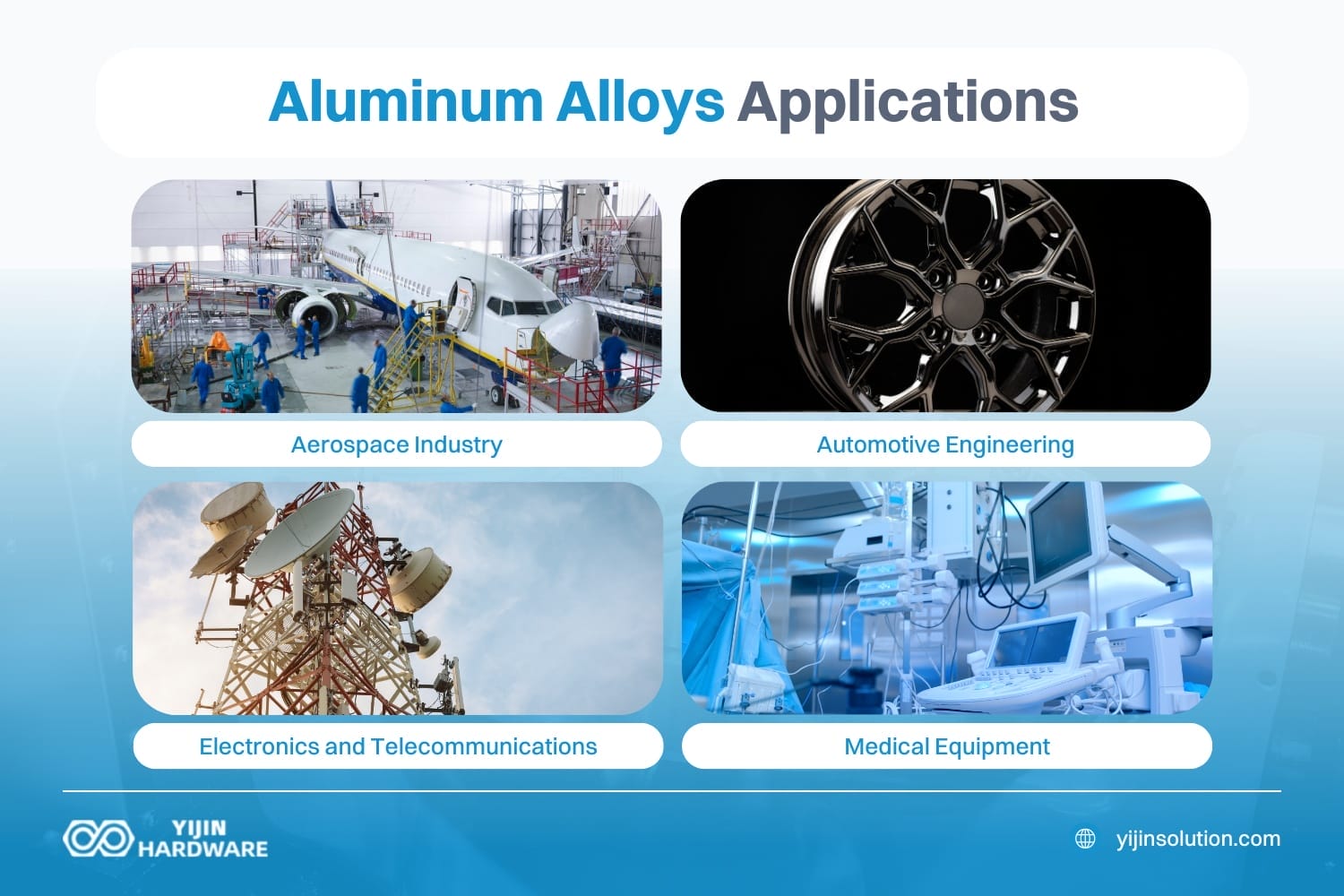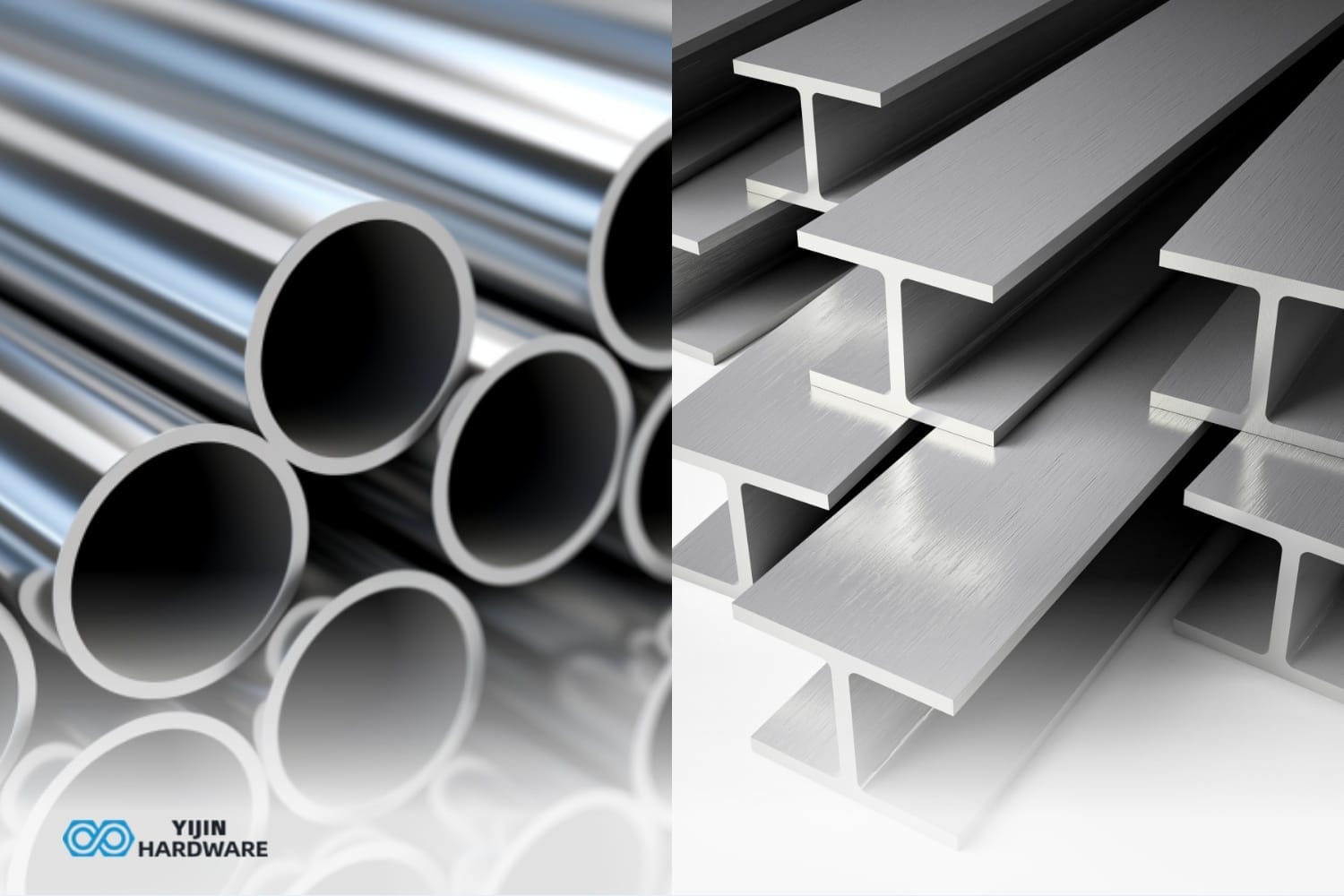An aluminum alloy is a type of aluminum with specific elements to enhance its mechanical properties while maintaining its lightweight characteristics. This makes them crucial in industries from aerospace to consumer electronics. Understanding their properties, types, and selection criteria is essential for optimal CNC machining results.
We’re Yijin Hardware, custom CNC machining and sheet metal fabrication experts who’ve worked extensively with aluminum alloys. Let’s break down what an aluminum alloy is, different types of aluminum, and which one you should choose for your CNC machining project.
Key Takeaways
- Aluminum alloys combine pure aluminum with other elements to boost strength, machinability, and corrosion resistance while keeping the material lightweight
- They are classified by standardized series and temper designations that guide selection for specific performance and machining requirements
- Their superior mechanical, thermal, and chemical properties make them indispensable for high-precision CNC machining in diverse industries
What is an Aluminum Alloy?

Aluminum alloy is a metal in which aluminum (Al) serves as the predominant element combined with other elements to enhance specific properties. Pure aluminum is soft, ductile, corrosion-resistant, and electrically conductive, but lacks strength for structural applications. Alloying with elements like copper, magnesium, silicon, manganese, and zinc overcomes this limitation.
The density of aluminum is approximately one-third that of steel (2.7 g/cm³ compared to 7.85 g/cm³), resulting in an impressive strength-to-weight ratio — which is particularly valuable in transportation applications where weight reduction translates to efficiency improvements.
How are Aluminum Alloys Classified?
Aluminum alloys are classified using a standardized classification system that provides immediate information about their composition and characteristics. 1000 series alloys are the purest type of aluminum alloy, with 99+% pure aluminum composition. 2000 to 8000 series designations tell you the primary alloying material the aluminum is created with.
| Series | Primary Alloying Element | Key Characteristics |
|---|---|---|
| 1xxx | None (99%+ pure aluminum) | Excellent corrosion resistance, high electrical conductivity, limited strength |
| 2xxx | Copper | High strength, heat-treatable, used in aerospace applications |
| 3xxx | Manganese | Moderate strength, good formability, used in cookware and heat exchangers |
| 4xxx | Silicon | Lower melting point, good flow properties, used as welding and brazing materials |
| 5xxx | Magnesium | Excellent corrosion resistance, good weldability, used in marine applications |
| 6xxx | Magnesium and Silicon | Good formability, corrosion resistance, medium strength, excellent extrudability |
| 7xxx | Zinc | Highest strength aluminum alloys, used in aerospace and high-stress applications |
| 8xxx | Other elements | Specialized alloys, including lithium-containing aerospace materials |
Beyond these numeral series characterisations, temper designations further classify aluminum alloys by their mechanical or thermal treatments:
- F: As fabricated
- O: Annealed (maximum ductility)
- H: Strain hardened (strengthened through cold working)
- T: Heat treated (thermally treated for stable properties)
- T4: Solution heat-treated and naturally aged
- T6: Solution heat-treated and artificially aged (peak strength)
For example, 6061-T6 indicates a 6061 alloy that has been solution heat-treated and artificially aged to achieve peak mechanical properties.
Why are Aluminum Alloys Essential in Modern Manufacturing?
Aluminum alloys serve as cornerstone materials in modern manufacturing, with global demand reaching approximately 29 million tons annually (22 million newly produced, 7 million recycled) according to Dalsteel Metals Pty Limited. These versatile materials address key manufacturing challenges by providing:
- Weight reduction without sacrificing structural integrity
- Excellent machinability for complex geometries
- Superior corrosion resistance
- Good thermal and electrical conductivity
- Recyclability with minimal property degradation
For CNC machining specifically, aluminum alloys offer significant advantages in processing speed, tool life, and dimensional accuracy.
What Properties of Aluminum Alloys Make it Ideal for CNC Machining?
The mechanical, physical, and chemical characteristics of alumnimum alloys make them particularly suitable for CNC machining applications. We’ve outlined each in greater detail to make it easier to understand the specifics of why aluminum alloy is so popular for CNC machining.
Mechanical Properties
Aluminum alloys offer remarkable versatility in their mechanical properties, allowing engineers to select the appropriate alloy based on specific application requirements:
| Property | Range | Examples |
|---|---|---|
| Ultimate Tensile Strength | 90-710 MPa (13-103 ksi) |
|
| Brinell Hardness |
|
|
| Elongation (Ductility) | 9-35% |
|
These alloys demonstrate excellent machinability characteristics, including high cutting speeds, good surface finish quality, and relatively low tool wear compared to many other metals. When properly machined, aluminum alloys can achieve excellent surface finishes down to mirror-like quality, making them ideal for applications requiring both precision and aesthetic appeal.
Physical Properties
The density of aluminum alloys is approximately one-third that of steel (2.7 g/cm³), creating significant weight advantages in transportation and portable applications. This property is particularly valuable in aerospace, automotive, and consumer electronics where weight reduction directly impacts performance and efficiency.
Their thermal conductivity is approximately three times greater than steel, which offers two key advantages:
- Facilitates efficient chip removal during machining
- Enhances heat dissipation, maintaining dimensional accuracy by preventing localized heating issues
Electrical conductivity in aluminum alloys ranges between 30-59% of the International Annealed Copper Standard (IACS), making them suitable for electrical applications while offering substantial weight advantages over copper.
Chemical Properties
Aluminum alloys naturally form a protective oxide layer on their surface, providing good corrosion resistance in many environments without additional treatments. This self-healing layer continuously reforms when damaged, offering ongoing protection against environmental factors.
Most aluminum alloys can be anodized to enhance:
- Surface hardness
- Wear resistance
- Corrosion protection
- Aesthetic appearance through various coloring options
These materials generally demonstrate good resistance to many chemicals, though they do have specific vulnerabilities to certain substances that must be considered in application-specific environments, particularly in settings involving strong acids or alkalis.
The combination of these verified properties makes aluminum alloys an exceptional choice for CNC machining operations across diverse industries, from aerospace and automotive to medical devices and consumer products.
Which Aluminum Alloys Perform Best in CNC Machining Applications?
Nearly all aluminum alloys are a popular choice for CNC machining, but 6061, 7075, and 2024 are often the most popular choices for machining. This table outlines the primary alloying elements and mechanical properties that help along the CNC maching process.
| Alloy | Primary Alloying Elements | Mechanical Properties (Temper) |
|---|---|---|
| 6061 | Magnesium, Silicon |
|
| 7075 | Zinc, Magnesium, Copper |
|
| 2024 | Copper, Magnesium, Manganese |
|
| 5052 | Magnesium |
|
| 7068 | Zinc, Magnesium, Copper, Zirconium |
|
Where are Aluminum Alloys Used in Real-World Applications?

Aluminum alloys are used in the aerospace, automotive, electronics, and medical industries. No matter the industry, various aluminum alloys are a staple material for CNC machining applications.
Aerospace Industry
The aerospace sector relies heavily on aluminum alloys for critical components due to their exceptional strength-to-weight ratio. Aircraft structures extensively utilize 2024 and 7075 alloys for fuselage frames and wing spars, where their high strength provides the necessary structural integrity while minimizing weight.
In space applications, specialized aluminum-lithium alloys are preferred for fuel tanks and structural elements, offering additional weight savings while maintaining properties necessary for aerospace performance. These alloys continue to be fundamental materials in both commercial and military aircraft, despite increasing use of composite materials in modern designs.
Automotive Engineering
Automotive manufacturers increasingly incorporate aluminum alloys to reduce vehicle weight and improve fuel efficiency without compromising safety or performance. Engine components frequently employ 356 and A380 cast alloys for blocks and cylinder heads, while 4032 alloy is preferred for pistons because of its thermal properties. For body structures, 5000 and 6000 series alloys are widely utilized in panels and frames, enabling weight reductions of up to 40% compared to steel equivalents.
This weight saving translates directly to improved fuel economy and reduced emissions, making aluminum alloys strategically important in modern vehicle design, particularly as electrification increases demand for lightweight construction.
Electronics and Telecommunications
The electronics industry leverages aluminum alloys’ thermal and electrical properties for various critical applications. Heat sinks manufactured from 6061 and 6063 alloys provide efficient thermal management for components in computers, power supplies, and LED lighting systems, dissipating heat that could otherwise damage sensitive electronics.
For device enclosures, 5052 and 6061 alloys are extensively used, offering multiple advantages including effective electromagnetic interference (EMI) shielding, impact resistance, and heat dissipation. The combination of functional properties and aesthetic appeal makes aluminum alloys particularly valuable in consumer electronics, where performance and design are equally important considerations.
Medical Equipment
Aluminum alloys play an essential role in medical device manufacturing, where their combination of lightweight properties and corrosion resistance provides significant advantages. Imaging equipment such as MRI and CT scanner frames predominantly utilize 6061 and 5052 alloys, which offer the necessary structural support while remaining completely non-magnetic—a critical requirement for magnetic resonance imaging systems.
For surgical tools, 6061 and 7075 alloys are commonly selected for instrument handles and non-implant devices, providing ergonomic benefits while withstanding sterilization processes. The material’s versatility makes it valuable across numerous medical applications, from diagnostic equipment to surgical instruments and hospital furnishings.
How do You Choose the Right Aluminum Alloy for Your Project?
Selection requires evaluating multiple factors to balance performance, manufacturing, and cost. We’ve made a matrix for you to refer to when next you consider an aluminum alloy for your project.
| Requirement Priority | Recommended Alloy Series | Specific Alloy Examples |
|---|---|---|
| Maximum strength | 7xxx series | 7075-T6, 7068-T6511 |
| Excellent machinability | 2xxx, 6xxx series | 2024-T351, 6061-T6 |
| Corrosion resistance | 5xxx, 6xxx series | 5052-H32, 6061-T6 |
| Complex geometry | 6xxx series | 6061-T6, 6063-T5 |
| Thin-wall machining | 6xxx series | 6061-T6 |
| High temperature stability | 2xxx, 7xxx series | 2024-T351, 7075-T6 |
| Anodizing quality | 6xxx series | 6061-T6, 6063-T5 |
| Electrical applications | 1xxx, 6xxx series | 1100-H14, 6101-T6 |
| Cost-effective general purpose | 6xxx series | 6061-T6 |
For your CNC machining and sheet metal fabrication needs, including using aluminum alloys, look no further than Yijin Hardware. Utilize our experts and bring your project to life with CNC machining today.
FAQs on What is Aluminum Alloy?
Is aluminum alloy good quality?
Aluminum alloys offer excellent quality for numerous applications due to their unique combination of lightweight properties, corrosion resistance, and good machinability. Different aluminum alloys provide varying levels of strength, with options ranging from 90 MPa for annealed 1100 to 710 MPa for 7068-T6511, allowing engineers to select the appropriate alloy based on specific performance requirements. Their quality is further demonstrated through widespread use in demanding industries including aerospace, automotive, and medical equipment manufacturing.
What is the difference between aluminium and aluminium alloy?
Pure aluminum is a soft, lightweight metal containing at least 99% aluminum content, while aluminum alloys combine aluminum with specific amounts of other elements such as copper, magnesium, zinc, or silicon to enhance particular properties. This alloying process significantly improves mechanical properties like strength and hardness, which are relatively limited in pure aluminum, while maintaining beneficial characteristics such as low density and corrosion resistance. While pure aluminum provides excellent electrical conductivity and corrosion resistance, aluminum alloys offer greater strength and versatility across a wider range of applications.
What’s the downside of aluminum alloys?
The primary limitations of aluminum alloys include lower strength compared to steel or titanium, susceptibility to deformation under heavy loads, and relatively low melting points that restrict use in high-temperature environments. Certain aluminum alloys can be challenging to weld due to their high thermal conductivity and susceptibility to cracking, while their lower hardness compared to some other metals limits applications requiring exceptional wear resistance. Additionally, some aluminum alloys are vulnerable to galvanic corrosion when in contact with dissimilar metals, requiring proper protective measures in certain environments.
Back to Top: What are Aluminum Alloys? | Aluminum Alloy Types Explained








